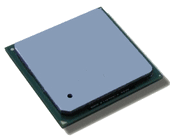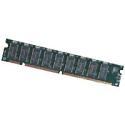Unit 07: PC system
A. Read the text below and then sentences 1 to 8. Decide if the sentences are true (T) or false (F).
What's inside a PC system? The nerve center of a PC is the central processing unit or CPU. This unit is built into a single microprocessor chip — an integrated circuit — which executes program instructions and supervises the computer's overall operation. The unit consists of three main parts: i the control unit, which examines the instructions in the user's program, interprets each instruction and causes the circuits and the rest of the components — disk drives, monitor, etc — to be activated to execute the functions specified; ii the arithmetic logic unit (ALU), which performs mathematical calculations (+, -, etc.) and logical operations (and, or, etc.); iii the registers, which are high-speed units of memory used to store and control information. One of the registers is the program counter (PC) which keeps track of the next instruction to be performed in the main memory. Another is the instruction register (IR) which holds the instruction that is currently being executed (see Fig. 1). One area where microprocessors differ is in the amount of data — the number of bits — they can work with at a time. There are 16, 32 and 64-bit processors. The computer's internal architecture is evolving so quickly that the new 64-bit processors are able to address 4 billion times more information than a 32-bit system. The programs and data which pass through the central processor must be loaded into the main memory (also called the internal memory) in order to be processed. Thus, when the user runs an application, the microprocessor looks for it on secondary storage devices (disks) and transfers a copy of the application into the RAM area. RAM (Random Access Memory) is temporary, i.e. its information is lost when the computer is turned off. However, the ROM section (Read Only Memory) is permanent and contains instructions needed by the processor. Most of today's computers have internal expansion slots that allow users to install adapters or expansion boards. Popular adapters include high-resolution graphics boards, memory expansion boards, and internal modems. The power and performance of a computer is partly determined by the speed of its microprocessor. A clock provides pulses at fixed intervals to measure and synchronize circuits and units. The clock speed is measured in MHz (megahertz) or GHz (gigahertz) and refers to the frequency at which pulses are emitted. For example, a CPU running at 1,600 MHz (1 millions cycles per second) will enable the computer to handle the most demanding applications. |
| Central
processing unit (CPU) |
Organization of a simple computer |
||||||||||||||||||||||||||||||||||||||||||||||||||
| Control
Unit |
Main memory |
||||||||||||||||||||||||||||||||||||||||||||||||||
| Arithmetic Logic Unit |
|
||||||||||||||||||||||||||||||||||||||||||||||||||
| Registers
|
|||||||||||||||||||||||||||||||||||||||||||||||||||

 A RAM chip
A RAM chip
| Microprocessor chip |
| The RAM capacity can sometimes be expanded by adding extra chips. These are usually contained in small circuit boards called single in-line memory modules (SIMMs). Modern Pentium processors also accept dual in-line memory modules (DIMMs), DDR2, and DDR3 which allow for a wider data path. |
Contextual Reference
Recebem o nome de REFERENTES aquelas palavras cuja função é a de referir-se a outros elementos que podem já ter sido mencionados anteriormente no texto ou que ainda o serão. Os principais referentes são: